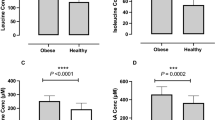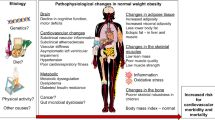Abstract
Background/Objectives:
Although energy restriction contributes to weight loss, it may also reduce energy expenditure, limiting the success of weight loss in the long term. Studies have described how genetics contributes to the development of obesity, and uncoupling proteins 1 and 2 (UCP1 and UCP2) and beta-3-adrenoceptor (ADRB3) have been implicated in the metabolic pathways that culminate in this condition. This study aimed to evaluate how the UCP1, UCP2 and ADRB3 genes influence weight loss in severely obese women submitted to hypocaloric dietary intervention.
Subjects/Methods:
This longitudinal study included 21 women divided into two groups: Group 1 (Dietary intervention (G1)) consisted of 11 individuals with severe obesity (body mass index (BMI) ⩾40 kg/m2), selected for dietary intervention and Group 2 (Control (G2)) consisted of 10 normal-weight women (BMI between 18.5 and 24.9 kg/m2). Evaluation included weight (kg), height (m), waist circumference (cm), body composition, resting metabolic rate (RMR, kcal) and abdominal subcutaneous adipose tissue collection. The dietary intervention required that G1 patients remained hospitalized in the university hospital for 6 weeks receiving a hypocaloric diet (1200 kcal per day). The statistical analyses included t-test for paired samples, Spearman correlation and multivariate linear regressions, with the level of significance set at P<0.05.
Results:
Weight (155.0±31.4–146.5±27.8 kg), BMI (58.5±10.5–55.3±9.2 kg/m2), fat-free mass (65.4±8.6–63.1±7.1 kg), fat mass (89.5±23.0–83.4±21.0 kg) and RMR (2511.6±386.1–2324.0±416.4 kcal per day) decreased significantly after dietary intervention. Multiple regression analyses showed that UCP2 expression contributed to weight loss after dietary intervention (P=0.05).
Conclusions:
UCP2 expression is associated with weight loss after hypocaloric diet intervention.
This is a preview of subscription content, access via your institution
Access options
Subscribe to this journal
Receive 12 print issues and online access
$259.00 per year
only $21.58 per issue
Buy this article
- Purchase on Springer Link
- Instant access to full article PDF
Prices may be subject to local taxes which are calculated during checkout


Similar content being viewed by others
References
Frood S, Johnston LM, Matteson CL, Finegood DT . Obesity, complexity, and the role of the health system. Curr Obes Rep 2013; 2: 320–326.
Moreles A, Martinez JA, Marti A . Genetics of obesity. Curr Obes Rep 2013; 2: 23–31.
Pi-Sunyer X . The medical risks of obesity. Postgrad Med 2009; 121: 21–33.
Haidar YM, Cosman BC . Obesity epidemiology. Clin Colon Rectal Surg 2011; 24: 205–210.
Cowburn G, Hillsdon M, Hankey CR . Obesity management by life-style strategies. Br Med Bull 1997; 53: 389–408.
Dulloo AG, Jacquet J, Montani JP, Schutz Y . Adaptive thermogenesis in human body weight regulation: more of a concept than a measurable entity? Obes Rev 2012; 2: 105–121.
Hasson RE, Howe CA, Jones BL, Freeddon PS . Accuracy of four resting metabolic rate prediction equations: effects of sex, body mass index, age, and race/ethnicity. J Sci Med Sport 2011; 14: 344–351.
Ordovás JM, Robertson R, Cléirigh EN . Gene–gene and gene–environment interactions defining lipid-related traits. Curr Opin Lipidol 2011; 22: 129–136.
Hinney A, Vogel CI, Hebebrand J . From monogenic to polygenic obesity: recent advances. Eur Child Adolesc Psychiatry 2010; 19: 297–310.
Klaus S . Adipose tissue as a regulator of energy balance. Curr Drug Targets 2004; 5: 241–250.
Depieri TZ, Pinto RR, Catarin JK, de Carli MC, Garcia-Júnior JR . UCP-3: regulação da expressão gênica no músculo esquelético e possível relação com o controle do peso corporal. Arq Bras Endocrinol Metabol 2004; 48: 337–344.
Mingrone G, Rosa G, Greco AV, Manco M, Vega N, Hesselink MK et al. Decreased uncoupling protein expression and intramyocytic triglyceride depletion in formerly obese subjects. Obes Res 2003; 11: 632–640.
Diano S, Horvath TL . Mitochondrial uncoupling protein 2 (UCP2 in glucose and lipid metabolism. Trends Mol Med 2012; 18: 52–58.
Toda C, Diano S . Mitochondrial UCP1 in the central regulation of metabolism. Best Pract Res Clin Endocrinol Metab 2014; 28: 757–764.
Ursino MG, Vasina V, Raschi E, Crema F, De Ponti F . The b3-adrenoreceptor as a therapeutic target: current perspectives. Pharmacol Res 2009; 59: 221–234.
Saliba LF, Reis RS, Brownson RC, Hino AA, Tureck LV, Valko C et al. Obesity-related gene ADRB2 ADRB3 and GHRL polymorphisms and the response to a weight loss diet intervention in adult women. Genet Mol Biol 2014; 37: 15–22.
Masuo K, Lambert GW . Relationships of adrenoceptor polymorphisms with obesity. J Obes 2011; 2011: 609485.
Shiwaku K, Nogi A, Anuurad E, Kitajima K, Enkhmaa B, Shimono K et al. Difficulty in losing weight by behavioral intervention for women with Trp64Arg polymorphism of the beta3-adrenergic receptor gene. Int J Obes Relat Metab Disord 2003; 27: 1028–1036.
Pena SD, Di Pietro G, Fuchshuber-Moraes M, Genro JP, Hutz MH, Kehdy Fde S et al. The genomics ancestry of individuals from different geographical regions of Brazil is more uniform than expected. PLoS One 2011; 6: e17063.
Jakicic JM, Wing RR, Lang W . Bioelectrical impedance analysis to assess body composition in obese adult women: the effect of ethnicity. Int J Obes Relat Metab Disord 1998; 22: 243–249.
Weijs PJ, Vansant GA . Validity of predictive equations for resting energy expenditure in Belgian normal weight to morbid obese women. Clin Nutr 2010; 29: 347–351.
Weir JB . New methods for calculating metabolic rate with special reference to protein metabolism. J Physiol 1949; 109: 1–9.
Chomczynski P, Sacchi N . Single-step method of RNA isolation by acid guanidiniumthiocyanate-phenol-chloroform extraction. Anal Biochem 1987; 162: 156–159.
Bustin SA, Benes V, Garson JA, Hellemans J, Huggett J, Kubista M et al. The MIQE guidelines: minimum information for publication of quantitative real-time PCR experiments. Clin Chem 2009; 55: 611–622.
Brown A, Gouldstone A, Fox E, Field A, Todd W, Shakher J et al. Description and preliminary results from a structured specialist behavioral weight management group intervention: Specialist Lifestyle Management (SLiM) programme. BMJ Open 2015; 5: 1–10.
Nicklas BJ, Wang X, You T, Lyles MF, Demons J, Easter L et al. Effect of exercise intensity on abdominal fat loss during calorie restriction in overweight and obese postmenopausal women: a randomized, controlled trial. Am J Clin Nutr 2009; 89: 1043–1052.
Foster-Schubert KE, Alfano CM, Duggan CR, Xiao L, Campbell KL, Kong A et al. Effect of diet and exercise, alone or combined, on weight and body composition in overweight-to-obese postmenopausal women. Obesity 2012; 20: 1628–1638.
Thomson RL, Buckley JD, Noakes M, Clifton PM, Norman RJ, Brinkworth GD . The effect of a hypocaloric diet with and without exercise training on body composition, cardiometabolic risk profile, and reproductive function in overweight and obese women with polycystic ovary syndrome. J Clin Endocrinol Metab 2008; 93: 3373–3380.
Jaime TJ, Balich LL, Acevedo GB, Cave MPM, Birn SH, Parada SH et al. Effect of calorie restriction on energy expenditure in overweight and obese adult women. Nutr Hosp 2015; 31: 2428–2436.
Hill JO, Wyatt HR, Peters JC . Energy balance and obesity. Circulation 2012; 126: 126–132.
Faria SL, Faria OP, Buffington C, Almeida Cardeal M, Gouvêa HR . Energy expenditure before and after roux-en-y gastric bypass. Obes Surg 2012; 22: 1450–1455.
Bosy-Westphal A, Schautz B, Lagerpusch M, Pourhassan M, Braun W, Goele K et al. Effect of weight loss and regain on adipose tissue distribution, composition of lean mass and resting energy expenditure in young overweight and obese adults. Int J Obes 2013; 37: 1371–1377.
Martin CK, Heilbronn LK, Jonge L, DeLany JP, Volaufova J, Anton SD et al. Effect of calorie restriction on resting metabolic rate and spontaneous physical activity. Obesity 2007; 15: 2964–2973.
Busiello RA, Savarese S, Lombardi A . Mitochondrial uncoupling proteins and energy metabolism. Front Physiol 2015; 6: 1–7.
Knudsen JG, Murholm M, Carey AL, Bienso RS, Basse AL, Allen TL et al. Role of IL-6 in exercise training- and cold-induced UCP1 expression in subcutaneous white adipose tissue. PLoS One 2014; 9: 1–8.
Liu J, Li J, Li WJ, Wang CM . The role of uncoupling proteins in diabetes mellitus. J Diabetes Res 2013; 2013: 585897.
Klaus S, Keipert S, Rossmeisl M, Kopecky J . Augmenting energy expenditure by mitochondrial uncoupling: a role of AMP-activated protein kinase. Genes Nutr 2012; 7: 369–386.
Petrovic N, Walden TB, Shabalina IG, Timmons JA, Cannon B, Nedergaard J . Chronic peroxisome proliferator-activated receptorγ (PPARγ activation of epididymally derived white adipocyte cultures reveals a population of thermogenically competent, UCP1-containing adipocytes molecularly distinct from classic brown adipocytes. J Biol Chem 2010; 285: 7153–7164.
Wu J, Cohen P, Spiegelman BM . Adaptive thermogenesis in adipocytes: is beige the new brown? Genes Dev 2013; 27: 234–250.
Wu J, Boström P, Sparks LM, Ye L, Choi JH, Giang AH et al. Beige adipocytes are a distinct type of thermogenic fat cell in mouse and human. Cell 2012; 150: 366–376.
Millet L, Vidal H, Andreelli F, Larrouy D, Riou JP, Ricquier D et al. Increased uncoupling protein–2 and –3 m RNA expression during fasting in obese and lean humans. J Clin Invest 1997; 100: 2665–2670.
Oberkofler H, Liu YM, Esterbauer H, Hell E, Krempler F, Patsch W . Uncoupling protein-2 gene: reduced mRNA expression in intraperitoneal adipose tissue of obese human. Diabetologia 1998; 41: 940–946.
Mahadik SR, Lele RD, Saranath D, Seth A, Parikh V . Uncoupling protein-2 (UCP1 gene expression in subcutaneous and omental adipose tissue of Asian Indians. Adipocyte 2012; 1: 101–107.
Acknowledgements
We thank Vivian Marques Miguel Suen and Priscila Giacomo Fassini for their expert assistance. This work was supported by grants #2013/070179-6 and #2013/08916-4 from the São Paulo Research Foundation (FAPESP). We thank the staff of the metabolic unit for their assistance during the development of this work.
Author information
Authors and Affiliations
Corresponding author
Ethics declarations
Competing interests
The authors declare no conflict of interest.
Rights and permissions
About this article
Cite this article
Cortes-Oliveira, C., Nicoletti, C., de Souza Pinhel, M. et al. UCP2 expression is associated with weight loss after hypocaloric diet intervention. Eur J Clin Nutr 71, 402–406 (2017). https://doi.org/10.1038/ejcn.2016.185
Received:
Revised:
Accepted:
Published:
Issue Date:
DOI: https://doi.org/10.1038/ejcn.2016.185
This article is cited by
-
Associations between obesity-related gene expression in maternal and cord blood and newborn adiposity: findings from the Araraquara Cohort study
International Journal of Obesity (2021)
-
UCP2 expression is negatively correlated with and body fat mass after combined physical training: a pilot study
Nutrire (2020)
-
DNA methylation pattern changes following a short-term hypocaloric diet in women with obesity
European Journal of Clinical Nutrition (2020)
-
Circulating levels of mitochondrial uncoupling protein 2, but not prohibitin, are lower in humans with type 2 diabetes and correlate with brachial artery flow-mediated dilation
Cardiovascular Diabetology (2019)



